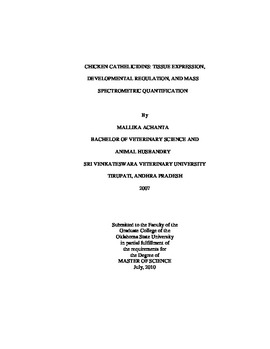| dc.contributor.advisor | Zhang, Guolong | |
| dc.contributor.author | Achanta, Mallika | |
| dc.date.accessioned | 2014-04-15T20:12:36Z | |
| dc.date.available | 2014-04-15T20:12:36Z | |
| dc.date.issued | 2010-07-01 | |
| dc.identifier.uri | https://hdl.handle.net/11244/8787 | |
| dc.description.abstract | The purposes of the study are to determine the tissue and developmental expressions of chicken cathelicidins and to develop a mass spectrometric assay for quantification of chicken cathelicidins. RNA was isolated from a panel of chicken tissues of different ages and real-;time PCR was performed to measure the gene expression levels of four chicken cathelicidins. A mass spectrometric method was also developed by employing LC-;MS/MS for quantification of fowl-;1(6-26)-;NH?, a chicken cathelicidin peptide analog. Four chicken cathelicidins were widely expressed in a variety of tissue types, with fowlicidins 1-;3 showing a more similar pattern than cathelicidin B1. Lung showed the highest expression of fowlicidins 1-;3, while cathelicidin B1 was expressed most abundantly in bursa of Fabricius. Four cathelicidins were differentially expressed during the early stages of development, largely with a gradual increase in bursa and cecal tonsil, two important immune organs in intestinal host defense. Collectively, our study of tissue and developmental expression patterns of four chicken cathelicidins has led to a better understanding of the chicken innate immunity as well as the development of the innate immune system. In the LC-;MS/MS assay, five different charge states of fowl-;1(6-;26)-;NH? ranging from +2 to +6 were detected, with the most intense ion being 501.31 ([M+5H]??), followed by 626.39 ([M+4H]??), 418.09 ([M+6H]??), and 835.19 ([M+3H]??). Results also showed the response curve for fowl-;1(6-;26)-;NH? is between 0.05 to 10.0??;g/ml with saturation of detection occurring above 10.0 ??;g/ml using the LC-;MS/MS approach that we developed. Taken together, these preliminary data have established a solid foundation on the quantification of the plasma concentrations of fowl-;1(6-;26)-;NH? peptide, which will be essential in calculating pharmacokinetic parameters. | |
| dc.format | application/pdf | |
| dc.language | en_US | |
| dc.publisher | Oklahoma State University | |
| dc.rights | Copyright is held by the author who has granted the Oklahoma State University Library the non-exclusive right to share this material in its institutional repository. Contact Digital Library Services at lib-dls@okstate.edu or 405-744-9161 for the permission policy on the use, reproduction or distribution of this material. | |
| dc.title | Chicken Cathelicidins: Tissue Expression, Developmental Regulation, and Mass Spectrometric Quantification | |
| dc.type | text | |
| dc.contributor.committeeMember | Hartson, Steve | |
| dc.contributor.committeeMember | Maxwell, Lara | |
| osu.filename | ACHANTA_okstate_0664M_11059.pdf | |
| osu.college | Agricultural Sciences and Natural Resources | |
| osu.accesstype | Open Access | |
| dc.description.department | Department of Animal Science | |
| dc.type.genre | Thesis | |
| dc.subject.keywords | assay | |
| dc.subject.keywords | chicken cathelicidins | |
| dc.subject.keywords | fowlicidin-1 peptide | |
| dc.subject.keywords | innate immunity | |
| dc.subject.keywords | liquid chromatography and mass spectrometry | |
| dc.subject.keywords | tissue expression | |
